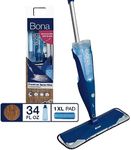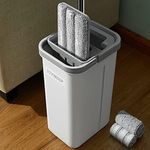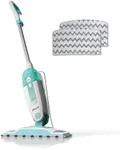Buying Guide for the Best Floor Mops
Choosing the right floor mop can make cleaning your home much easier and more effective. The best mop for you depends on your floor type, how often you clean, and your personal preferences for convenience and comfort. Understanding the key features of different mops will help you select one that fits your needs and makes your cleaning routine more efficient.Mop TypeThe type of mop refers to its design and cleaning mechanism, such as traditional string mops, flat mops, sponge mops, spray mops, or steam mops. This is important because each type is suited to different cleaning tasks and floor surfaces. For example, string mops are good for heavy-duty cleaning and absorbency, while flat mops are better for quick, everyday cleaning. Sponge mops work well on smooth surfaces, spray mops offer convenience for spot cleaning, and steam mops sanitize floors using heat. To choose the right type, consider your floor material (like tile, wood, or laminate), how dirty your floors get, and whether you prefer a mop that is easy to wring out or one that offers extra features like built-in spray or steam.
Mop Head MaterialThe mop head material affects how well the mop cleans and how easy it is to maintain. Common materials include cotton, microfiber, and sponge. Cotton is very absorbent and good for soaking up spills, but it can take longer to dry. Microfiber is popular because it traps dirt and dust effectively and dries quickly, making it suitable for most floor types. Sponge heads are great for smooth surfaces and can be rinsed easily. When picking a mop, think about whether you need something that handles tough messes, dries quickly, or is gentle on delicate floors.
Handle Length and AdjustabilityThe length of the mop handle and whether it can be adjusted is important for comfort and ease of use. A handle that is too short can cause back strain, while a handle that is too long may be awkward to maneuver. Adjustable handles let you set the mop to a comfortable height for your body, making cleaning less tiring. If you are tall or have back issues, look for a mop with an adjustable or longer handle to make cleaning more comfortable.
Wringing MechanismThe wringing mechanism is how you remove excess water from the mop head. Some mops have a built-in wringer, a twist mechanism, or a lever, while others require a separate bucket with a wringer. This feature is important because it affects how wet the mop is when you use it, which can impact cleaning effectiveness and floor safety. If you want to avoid touching dirty water or need to control moisture for sensitive floors, choose a mop with an easy-to-use wringing system.
Ease of Cleaning and MaintenanceHow easy it is to clean and maintain your mop will affect how long it lasts and how hygienic it stays. Some mop heads are machine washable, while others need to be replaced regularly. A mop that is easy to rinse and dry will help prevent odors and bacteria buildup. If you want a low-maintenance option, look for mops with removable, washable heads or those that are easy to replace.
Compatibility with Floor TypesNot all mops are suitable for every floor type. Some are designed for hard surfaces like tile or vinyl, while others are gentle enough for wood or laminate. Using the wrong mop can damage your floors or leave them too wet. Always check if the mop is recommended for your specific floor type, and if you have multiple types of flooring, consider a versatile mop that works well on all of them.

















